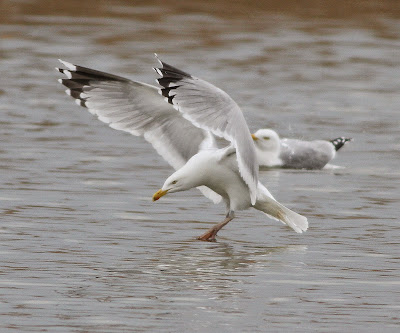35 years ago, in late March 1981, I spent a weekend twitching in the Penzance & Hayle area of Cornwall looking for my first Bonaparte's Gull. After an unsuccessful first day, we finally caught up with it on the Sunday morning, after Keith Vinicombe located it a long way out on the Hayle estuary mud. Two weeks later, we were planning the next weekend of Birding. There were no major ticks to take our fancy, so a weekend of camping at Portland Bill was the plan. It should have had migrants, but my notebooks said it was a quiet weekend. But we did see the Bonaparte's Gull again. It would have been a Dorset Tick, but living in Southampton, Hampshire in those days, meant I wasn't interested in a Dorset List. It was the highlight of the weekend & gave great views down to 10 metres at Radipole on 4 Apr 1981. We didn't see it on the following day, but it was still in the Weymouth area as we saw it a couple of weeks later.
Herring Gull: Just getting the camera set up for photographing Gulls
Moving forward to this year on 7 Mar, a Bonaparte's Gull was found at Ferrybridge before moving to Portland Harbour. I didn't make the effort to go down to look for it, which was clearly a good plan as it was very elusive in these early days. Peter Moore ended up having to make three attempts to photograph it, although he did see it, on the first occasion. After a couple of weeks of no sightings, it looked like it had quickly moved through. Then it reappeared at Radipole & quickly settled down into a pattern of showing from mid-morning to mid-afternoon. I planned to visit on 4 Apr, which would have been exactly 35 years on from my first Dorset sighting. But following the brief appearance of a singing Serin at Corfe Castle, I ended up spending several hours unsuccessfully trying to relocate that individual. So one day later, I was down at Radipole looking. As soon as I started arrived at the tennis courts, I could see it feeding off the Buddilea loop trail. Heading to the end of the Buddilea loop trail, got me close at times, but frustratingly it often moved to the tennis courts end to feed. Eventually, I ended up back there again. So 35 years & a day after my first & only Dorset Bonaparte's Gull at Radipole, I was back there again to see my next. Maybe if there is another Bonaparte's in another 35 years & a day, I won't have to lug a heavy 400mm lens & Canon 7D around, as the technology will have moved on so I can produce as good an image from a camera in my glasses or watch. Having said that I probably won't be around in 2050 to find out!
Bonaparte's Gull: 1st Summer. This is only the sixth Dorset record with 3 one day records: Durlston (Mar 1970); Portland (Mar 1990) & Weymouth (Apr 2006). The 1981 Weymouth individual stayed from 2 Apr to 8 June. The other record was a four day individual at Stanpit (Apr 1975)
Bonaparte's Gull: 1st Summer. A really striking upperwing clean-cut pattern
Bonaparte's Gull: 1st Summer. They are a small Gull, but this Herring Gull was the only Gull it sat next to for a size comparison
Bonaparte's Gull: 1st Summer. It gets the name from Charles Lucien Bonaparte (a nephew of Napoleon Bonaparte) who was a member of the Academy of Natural Sciences in Philidephia in the 1820s & worked as a zoologist on American ornithology
Bonaparte's Gull: 1st Summer. The extent of the translucency in the wing is striking
Bonaparte's Gull: 1st Summer. Note, the fine black bill
Bonaparte's Gull: 1st Summer. It spent a long time catching small flying insects above the water
Bonaparte's Gull: 1st Summer
Bonaparte's Gull: 1st Summer
Bonaparte's Gull: 1st Summer. Note, the small flying insect below its legs
Bonaparte's Gull: 1st Summer. A really striking upperwing clean-cut pattern
Bonaparte's Gull: 1st Summer. They are a small Gull, but this Herring Gull was the only Gull it sat next to for a size comparison
Bonaparte's Gull: 1st Summer. It gets the name from Charles Lucien Bonaparte (a nephew of Napoleon Bonaparte) who was a member of the Academy of Natural Sciences in Philidephia in the 1820s & worked as a zoologist on American ornithology
Bonaparte's Gull: 1st Summer. The extent of the translucency in the wing is striking
Bonaparte's Gull: 1st Summer. Note, the fine black bill
Bonaparte's Gull: 1st Summer. It spent a long time catching small flying insects above the water
Bonaparte's Gull: 1st Summer
Bonaparte's Gull: 1st Summer
Bonaparte's Gull: 1st Summer. Note, the small flying insect below its legs
Every now & then, it would disappear to feed for five to ten minutes on the tennis courts end. This gave me a chance to photograph a few of the other local species. While not being particularly unusual species, Radipole, is a good place to get close views & photographs of these species.
Mallard: Male. Some individuals just would not keep a reasonable distance to allow me to photograph the whole body

















